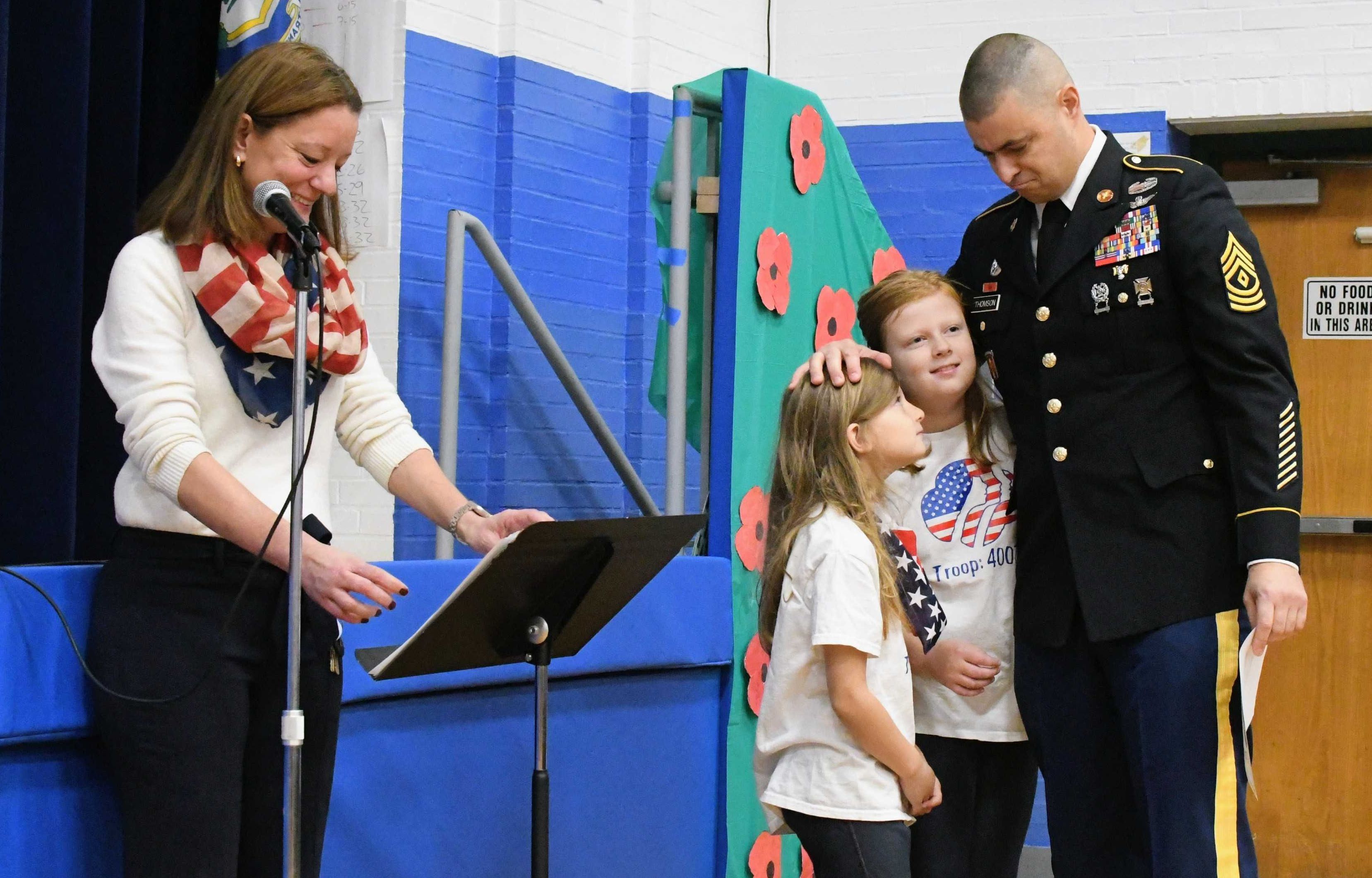Seeing Is Believing
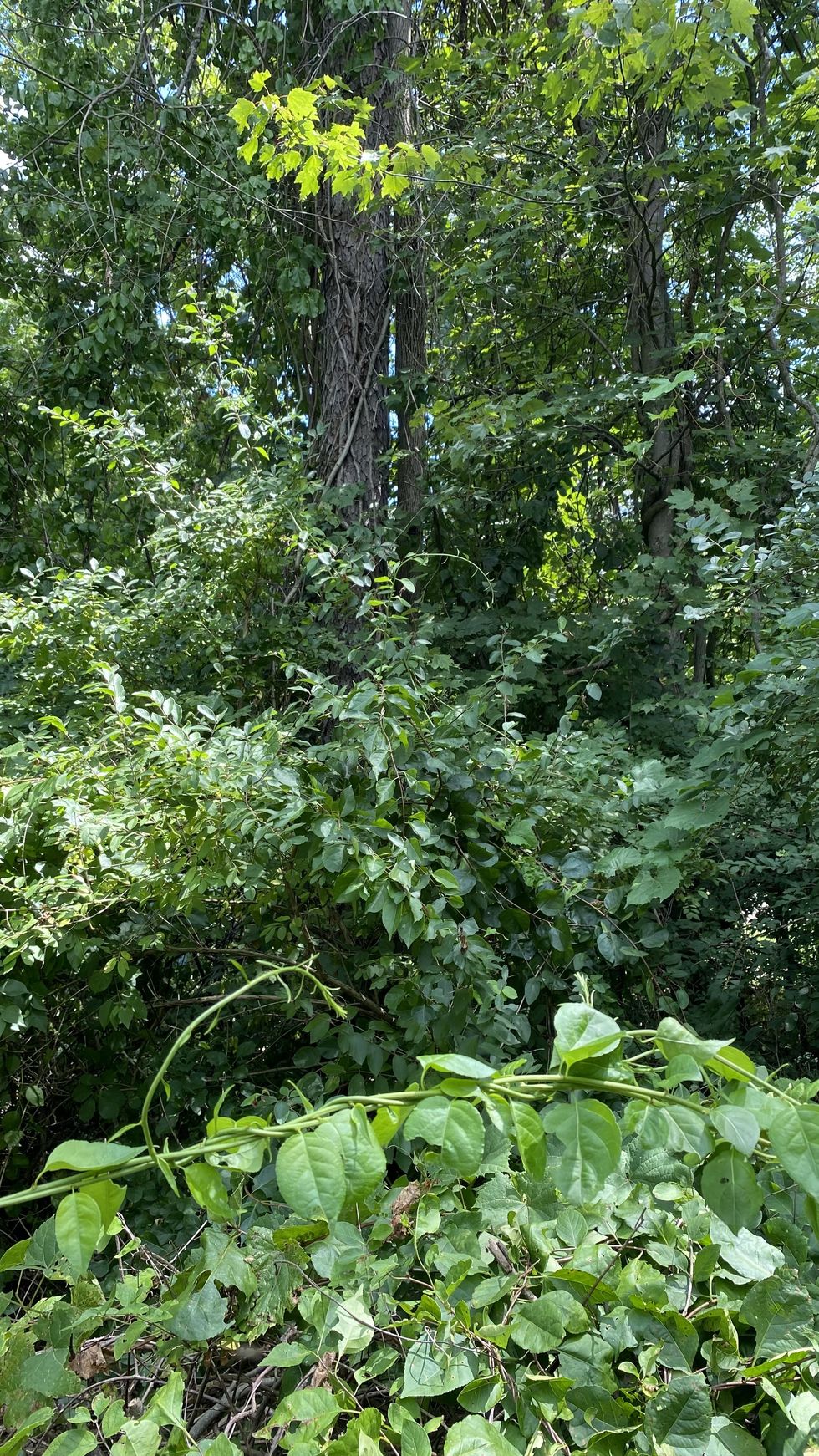
What might seem like lush greenery in our surroundings is often actually a choking non-native invasive.
Photo by Cynthia Hochswender

If, as is said, one can’t see the forest for the trees, might it also sometimes be true that one can’t see the trees for the forest?
Here’s an example: Some people look at their outdoor surroundings, see the green leaves and assume all is good around them. Others look at the same surroundings and see that the green leaves are actually invasive bittersweet vines and not the leaves of their host trees.
Many people fall into the former category; I did too. Ten years ago, we moved, as weekenders, to the banks of the Housatonic River in Litchfield County. As we began to look more closely at the trees surrounding our cottage and that marked the beginning of the woodland, we came to realize that the lush green foliage that attracted us to the property was in fact bittersweet vines growing on the dead or nearly dead trees it was choking.
How did we not perceive that the trees had been neglected for decades?
I started to make my way into the 10 acres of woodland that we purchased with the property. There was one short but clear path that led to a dumping area and from there I could see the sad reality of what was to become a decade-long effort.
Aided by knowledgeable friends and online information sources, we developed a triaged approach to our work. First, we had to get into the woods to be able to work safely. We removed some of the dead trees along the periphery of the woods, along with their bittersweet assassins, using a hand saw to cut the thick vine and carefully brushing glyphosate on the exposed cut. Critically, we never sprayed the glyphosate to ensure there was no collateral effect.
At the time, it seemed obvious to next remove the spikey shrub barberry as it made navigation difficult and painful. I found out years later that barberry plays a key role in undermining the woodland ecosystem. It turns the soil pH alkaline with its decomposing leaf litter and stacks the odds against native plants. Barberry removal is treacherous work and, for several infested areas, we enlisted help to speed the process along. I plan to write about this invasive shrub again in detail.
Once the woods could be accessed, we encountered young trees in the hundreds bound by bittersweet vines; almost all have been rescued over the course of the past 10 years. Unlike the older vines, these can be snipped with a pair of bypass loppers or pulled out by hand. Once unshackled (and some with scars in their bark as evidence of captivity) the trees were able to resume their rightful place, creating a critical understory in a mostly mature woodland. This is arduous but satisfying in the extreme.
Vine and barberry removal allowed me to see the woods in ways I did not think possible.
I developed an eagle eye for garlic mustard which, like bittersweet, is highly detrimental to the native woodland. Garlic mustard is allelopathic, meaning that it sends out chemicals in the soil that deter other plants from growing nearby. I could spot this villain in its early form as an innocent looking groundcover as well as its, later, elongated, seed-producing form.
Once expanses of land were cleared of invasives, I began to see new plants. These grew spontaneously, as if the “all clear” signal had been given. Shrubs, notably maple-leaf viburnum with their delicate white flowers, currant and later, after a few years of improving soil acidity, low-grow blueberry. Also delicate herbaceous plants: black cohosh, baneberry, Canada mayflower, trillium, partridgeberry and rare clubmoss are among the many gorgeous woodland plant life that emerged in place of the non-natives.
New trees became a time stamp of the work accomplished to eradicate the invasives: oaks, hickories, elms, maples (including moosewood, sycamore and box elder), beech, ironwood, witch hazel, basswood, white pine and hickory. And given the hurdles trees endure —destructive insects, drought, flood, wind — the understory requires many young recruits to create a mature tree canopy.
In my case, seeing was the first step to developing a fascinating, rich relationship with nature in general and the woods in particular. There are important environmental reasons to restore the land around us and I expect to cover these in future columns. But in much the same way that we spend time and money gardening— installing plants to create a multi-sensorial experience — here, in the woods and our meadows, we can ungarden, removing non-native plants to create the conditions for native re-growth and allow nature to gift us its own kind of multi-sensorial experience.
Dee Salomon “ungardens” in Litchfield County.
NEWTOWN — Housatonic Valley Regional High School's girls soccer team's state tournament run concluded in the semifinals with a 4-2 loss to Morgan High School Wednesday, Nov. 12.
The final four finish was the deepest playoff push for Housatonic since 2014. Lainey Diorio scored both goals and keeper Vi Salazar logged 10 saves in the semifinal game.
"It's an unfortunate loss but you know they played their hearts out," said HVRHS coach Don Drislane. "Awesome season."
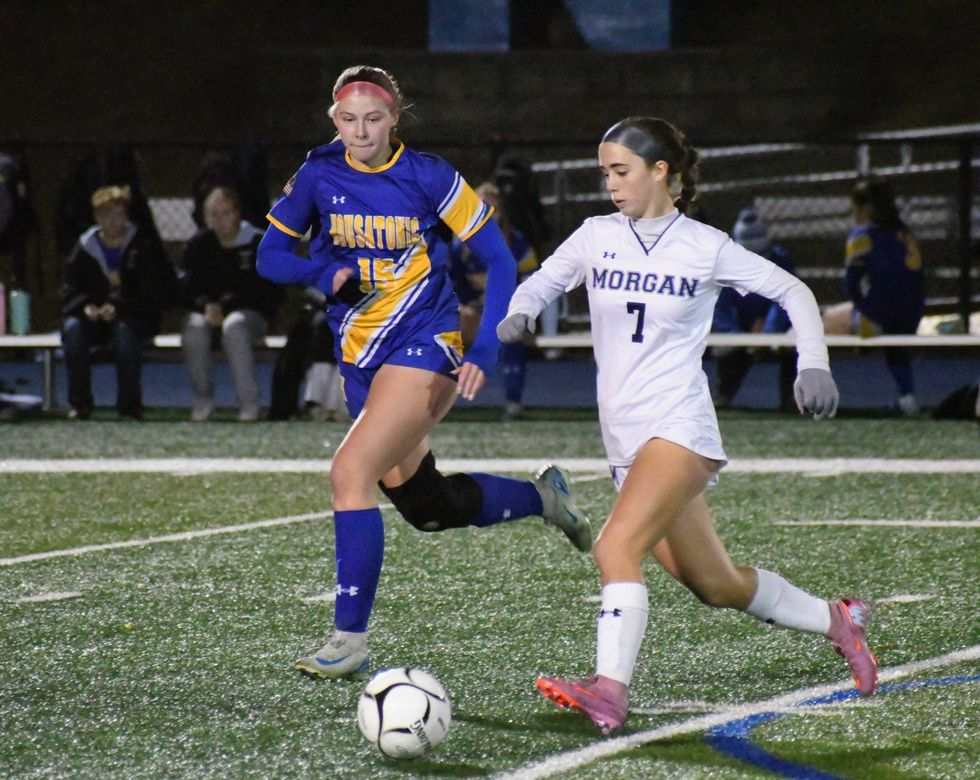
It was the final soccer game for HVRHS’s two senior captains: Ava Segalla and Madeline Mechare. Segalla ended her varsity career as the leading goal scorer in school history with a total of 133.
Morgan's size and speed on the field helped the Huskies dominate possession and earned them a bid to the Class S girls soccer championship for the second year in a row. In 2024, Morgan lost in penalty kicks to Coginchaug High School.
This year, the Huskies will face Old Saybrook High School in the Class S championship game at Trinity Health Stadium in Hartford on Saturday, Nov. 15 at 10 a.m. Old Saybrook defeated Canton High School 1-0 in the semis.
Local writer shares veterans’ stories in Malcolm Gladwell’s ‘Medal of Honor’ podcast
SHARON, Conn. — After 20 years as a magazine editor with executive roles at publishing giants like Condé Nast and Hearst, Meredith Rollins never imagined she would become the creative force behind a military history podcast. But today, she spends her days writing about some of the most heroic veterans in United States history for “Medal of Honor: Stories of Courage,” a podcast produced by Malcolm Gladwell’s company, Pushkin Industries.
From her early days in book publishing to two decades in magazines and later a global content strategist for Weight Watchers, Rollins has built a long and varied career in storytelling.
“I’ve learned a lot with each career shift, but the higher I went up the masthead, the less it was about writing and editing,” said Rollins. “I missed the creative process.”
While the podcast isn’t her first writing project, it marks her first foray into audio storytelling.
“During the pandemic I used to listen to mostly true crime podcasts when I was doing the laundry, driving my kids somewhere or working in the garden,” she said. Now Rollins gets to write one, and approaches each episode with awe and a reporter’s curiosity.
After 30 years of friendship with Malcolm Gladwell, the pair decided to collaborate on a project that would combine their shared journalism roots with stories that celebrate bravery and courage.
“Malcolm approached me about a project, and he was looking for a subject that he believed would really bring people together in this fractured political time we’re going through,” said Rollins.
Enter “Medal of Honor.”
The podcast’s namesake is the highest U.S. military decoration for valor, awarded for “conspicuous gallantry and intrepidity at the risk of life above and beyond the call of duty.” Each episode brings to life the story of a Medal of Honor recipient — often with the cinematic pacing and emotional resonance of a feature film.
“Medal of Honor” released its second season this summer, and production on a third season is underway. While Season One was narrated by Gladwell himself, Season Two introduced a new voice with firsthand experience. J.R. Martinez is a former U.S. Army soldier, author, motivational speaker and winner of Dancing with the Stars Season 13.
Writing for two very different narrators, Rollins said, has been both a challenge and a joy.
“As we’ve gotten to know each other and gotten deeper into this project together, I can almost predict how J.R. will react to certain moments,” she said. “He brings so much heart and humanity to the stories.”
Both her father and father-in-law served as Marines, but Rollins said military history was never top of mind until Gladwell pitched her the idea.
“The deeper you get into a subject you don’t know about, the more excited you get about it,” she said. “It’s been a way for me to learn about the incredible sacrifice woven into our country’s history.”
Rollins approaches each episode of “Medal of Honor” by looking first at the act of sacrifice itself, which she describes as “a moment that often happens in a flash.”
She dives deep into research, gathering biographical details from their upbringing and motivations to the circumstances that led them into combat. She then recreates the atmosphere of the conflict, setting the scene with vivid historical detail.
“These men would tell you they were just average guys,” said Rollins. “And if you believe that, then you have to believe we’re all capable of that same bravery or selflessness. It has really shown me the incredible courage we all have, and our ability to do right in the world.”
Chris Ohmen (left) held the flag while Chris Williams welcomed Salisbury residents to a Veterans Day ceremony at Town Hall Tuesday, Nov. 11.
SALISBURY — About 30 people turned out for the traditional Veterans Day ceremony at Salisbury Town Hall on a cold and snowy Tuesday morning, Nov. 11.
Chris Ohmen handled the colors and Chris Williams ran the ceremony.
Rev. John Nelson from Salisbury Congregational Church gave both an invocation and a benediction. The latter included this:
“We pray that those who have served and those who have died will never have done so in vain/We pray that the commitment of veterans will be an abiding call to resolve our conflicts without resorting to arms/ That one day soon we may mark the war that indeed ends all wars.”
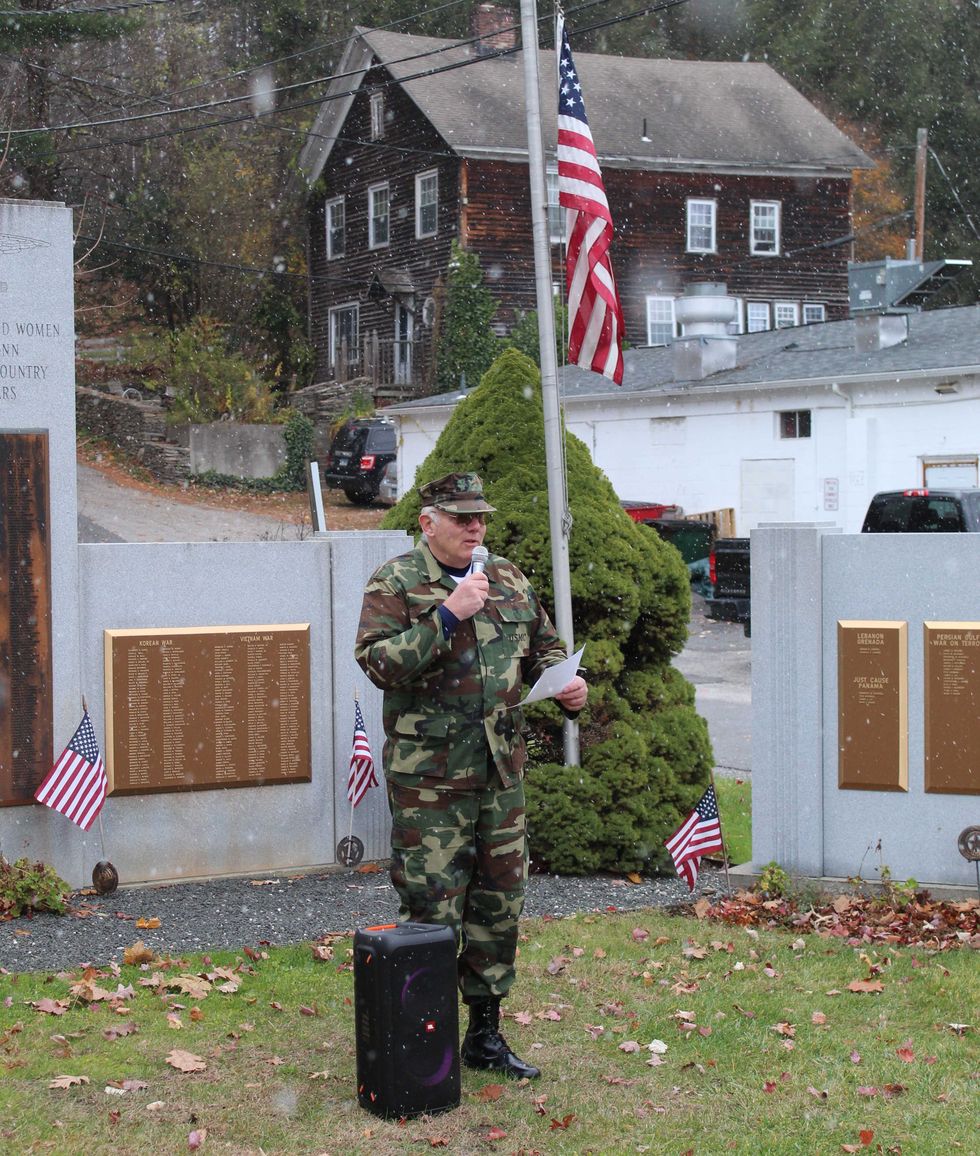
Williams began his remarks by noting that the Veterans Day speech was usually given by the late David Bayersdorfer, who died earlier this year.
“As we honor our veterans today, let’s keep in mind that service comes in many forms. Each role, each job, each post is a vital part of what makes our military the finest in the world.”
Lloyd Wallingford sang “God Bless America” a cappella, with the crowd joining in.
Eden Rost, left, shakes hands with Sergeant Nicholas Gandolfo, veteran of the Korean War.
NORTH CANAAN — Students at North Canaan Elementary School saluted servicemen and servicewomen at a Veterans Day ceremony Wednesday, Nov. 12.
Eighteen veterans were honored, many of whom attended the ceremony and were connected to the school as relatives of students or staff.
The 2nd graders sang the official song for each branch of service represented that day: Army, Navy, Coast Guard, Marines and Air Force. Special recognition was given to the Marine Corps, which was founded 250 years ago in November 1775.
Eighth graders offered speeches of appreciation. Taylor Gulotta said, "My older sister, Madison, has worked so hard to get to where she is today. She has dreamt of being in the Coast Guard since she was a little girl." She continued, "Her selflessness and bravery... is truly inspiring."
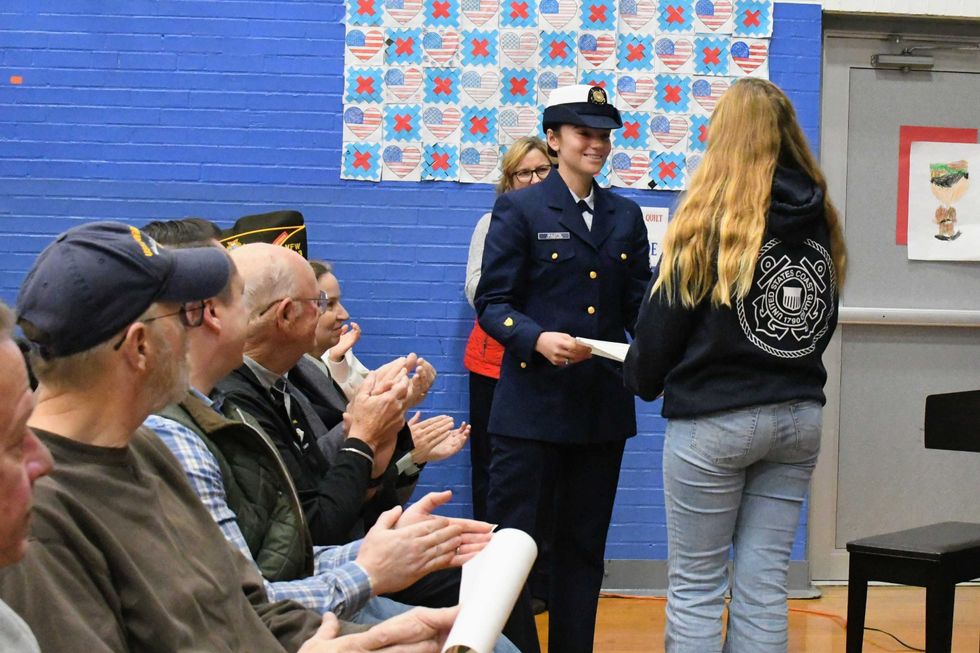
Brayden Foley spoke of his grandfather Todd Baldwin's time in the Navy. "My grandpa taught me that helping others in a fundamental way can build strong, meaningful relationship and a supportive community. I appreciate all members of the Armed Forces past and present for their bravery and their commitment to protect the freedom that we have today."
Veterans were recognized individually by Principal Beth Johnson and students presented them with certificates.
The 2nd graders closed the ceremony with a choreographed rendition of "Grand Old Flag."
